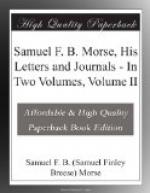It was at first thought necessary to insulate the whole length of the wire, and it was not until some time afterwards that it was discovered that naked wires could be successfully employed.
On August 10, in his report to the Secretary, he indulges in a prophecy which must have seemed in the highest degree visionary in those early days:—
“Some careful experiments on the decomposing power at various distances were made from which the law of propulsion has been deduced, verifying the results of Ohm and those which I made in the summer of 1842, and alluded to in my letter to the Honorable C.G. Ferris, published in the House Report, No. 17, of the last Congress.
“The practical inference from this law is that a telegraphic communication on my plan may with certainty be established across the Atlantic!
“Startling as this may seem now, the time will come when this project will be realized.”
On September 11, he reports an item of saving to the Government which illustrates his characteristic honesty in all business dealings:—
“I would also direct the attention of the Honorable Secretary to the payment in full of Mr. Chase, (voucher 215), for covering the wire according to the contract with him. The sum of $1010 was to be paid him. In the course of the preparation of the wire several improvements occurred to me of an economical character, in which Mr. Chase cheerfully concurred, although at a considerable loss to him of labor contracted for; so that my wire has been prepared at a cost of $551.25, which is receipted in full, instead of $1010, producing an economy of $458.75.”
The work of trenching was commenced on Saturday, October 21, at 8 A.M., and then his troubles began. Describing them at a later date he says:—
“Much time and expense were lost in consequence of my following the plan adopted in England of laying the conductors beneath the ground. At the time the Telegraph bill was passed there had been about thirteen miles of telegraph conductors, for Professor Wheatstone’s telegraph system in England, put into tubes and interred in the earth, and there was no hint publicly given that that mode was not perfectly successful. I did not feel, therefore, at liberty to expend the public moneys in useless experiments on a plan which seemed to be already settled as effective in England. Hence I fixed upon this mode as one supposed to be the best. It prosecuted till the winter of 1843-44. It was abandoned, among other reasons, in consequence of ascertaining that, in the process of inserting the wire into the leaden tubes (which was at the moment of forming the tube from the lead at melting heat), the insulating covering of the wires had become charred, at various and numerous points of the line, to such an extent that greater delay and expense would be necessary to repair the damage than to put the wire on posts.
“In my letter to the Secretary of the Treasury, of September 27, 1837, one of the modes of laying the conductors for the Telegraph was the present almost universal one of extending them on posts set about two hundred feet apart. This mode was adopted with success.”




